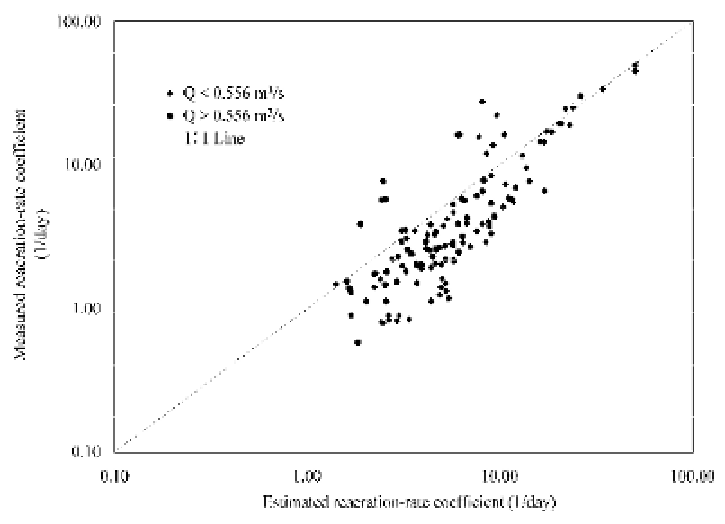Environmental Engineering Reference
In-Depth Information
scattergram of verification results in Fig. 9.6. The verification results are similar to the calibration results
indicating the usefullnes of Eqs. (9.14)-(9.17).
Fig. 9.6
For streams in the verification database, reaeration-rate coefficients measured and estimated with equations
developed from multiple linear regression for pool and riffle or channel control streams (whichever is better) in the USGS
database (after Melching and Flores, 1999)
As was true for
K
d
, the value of
K
a
is affected by temperature, and all the estimation equations yield
values of
K
a
for a temperature of 20
ć
. The temperature adjustment for
K
a
is computed as follows:
K K
˅
(9.18)
Short comings of the streeter-phelps model
—When Streeter and Phelps proposed their original model in
1925, relatively few municipal and industrial wastewaters were treated and CBOD concentrations were by
far the dominant cause of low DO concentrations. However, as more and more treatment plants applying
secondary treatment were built the importance of other dissolved oxygen demands became apparent.
These include the following processes that need to be considered to overcome the short comings of the
original Streeter-Phelps model.
(1) Removal of CBOD by sedimentation or adsorption [
K
3
in Eq. (9.1)],
(2) Nitrogenous biochemical oxygen demand (NBOD),
(3) Addition of CBOD and NBOD along the reach resulting from local runoff,
(4) Addition of CBOD and NBOD along the reach resulting from the scour of bottom deposits or by
diffusion of partly decomposed organic products from the benthic layer into the water column,
(5) Removal of oxygen from water by diffusion into the bethic layer to satisfy the oxygen demand of this
layer's aerobic zone,
(6) Removal of oxygen from the water column by the purging action of gases rising from the benthic layer,
(7) Addition of oxygen by photosynthetic action of plankton and macrophytes,
(8) Removal of oxygen by respiration of plankton and macrophytes, and
(9) Continuous redistribution of CBOD, NBOD, and DO by longitudinal dispersion.
Processes (4)-(6) often are referred to as an aggregate process called sediment oxygen demand (SOD),
(
(
)
u
1.024
(
T
)
aT
a
20


Search WWH ::

Custom Search